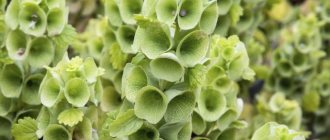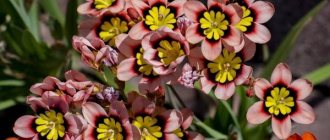The flowering plant Mirabilis is a member of the Nyctaginaceae family. This genus includes more than 50 species. Under natural conditions, they can be found in tropical and temperate regions, and they are most common in South and North America, but there is 1 species, whose homeland is South Asia. From Latin “mirabilis” is translated as “amazing”. This type of mirabilis, like jalapa, is also called the “night beauty”, and it has won great love among gardeners. These flowers are simple at first glance, but they have a mysterious appeal. When Mirabilis blooms, the garden is filled with a unique smell. It is distinguished by its unpretentiousness and undemandingness to growing conditions. Often, such a plant is used to form a not very high hedge, which looks bright and impressive.
Origin of Mirabilis
Bright tropical flowers with an unusual name are herbaceous plants. The Niktaginov family includes more than five dozen species.
Southern Guest Flower
Unfortunately, only one variety of night-blooming bushes has taken root in Russia. They call it Jalapa, but due to the lack of related species, the flower received the name of the entire family. The variegated flowers growing in the Russian Federation are simply called mirabilis.
And even on Russian soil, mirabilis has chosen a certain climate. He liked the warm southern latitudes. Since its homeland is South America, and the species itself is perennial, the bushes need moderate winters, which they found in the Russian outback.
Interesting! Mirabilis is often called the Night Beauty. It's all about the time of its flowering. The plant keeps the bud closed all day, and only in the evening the flower blooms.
Flowering lasts throughout the dark part of the day, and the next morning the bud fades.
Lush color
While one flower fades, the plant immediately produces new buds. The flowering season lasts until the first frost. Mirabilis often decides to bloom a flower in cloudy weather. Then you can admire the blooms during the day.
Thanks to its unpretentiousness, mirabilis has become a traditional debut for gardeners. Caring for a plant does not require special skills and is quite intuitive. In addition, no special equipment is needed to grow Nightflowers.
Mirabilis
Mirabilis itself is a perennial plant. However, those wishing to grow a night flower in cold regions will benefit from its annual cycle. To continue the work, it is enough to correctly collect the seeds and save them for the next season.
Mirabilis prices
mirabilis
What does Mirabilis look like?
Mirabilis has a rather attractive appearance. Neat bushes crowned with variegated inflorescences make you want to take up floriculture and certainly grow Night Dawn on your site.
Morning dew on Mirabilis
Since Mirabilis is a herbaceous species, the height of its bush rarely exceeds a meter. Most of the representatives growing in the south of Russia grow up to 80 cm. The structure of the bush itself is strong and well-knit. The trunks may be bare or pubescent. Their surface is often sticky. The leaves are thin, planted oppositely.
The root system of the plant is tuberous, the structure of the rods is convex. The plant comes from hot regions, so the structure of its root allows for the accumulation of moisture.
Mirabilis root system
Mirabilis blooms generously, opening up to 16 flowers at a time. They are located on the upper parts of the stem or in the axils of the crowns. The shape of the flower is elongated, partly reminiscent of a gramophone pipe. The front of the funnel widens. Often the edges of the petal are torn and cut.
A distinctive feature of mirabilis is a huge range of patterns and shades. Different inflorescences can form on one representative.
Variety of colors
Also on one flower there are multiple shades collected in striped patterns. There are also plain flowers. Mirabilis has a huge number of flowers in its arsenal. Ranging from pale yellow tones to dark burgundy shades. There are also pink samples, as well as completely white ones.
Yellow one-color bud
The end of flowering is marked by the appearance of fruits. After the flower withers, a small dark-colored box appears in its place. The brown fruit with a ribbed texture contains only one seed. By the time it matures, it acquires an elastic structure and a wrinkled surface. The seed is oval and quite large in size. There are about one and a half dozen pieces per gram of dried seeds. In favorable conditions, it can be preserved for three years.
Matthiola, or gray-haired left-wing (Matthiola incana)
Levkoy is a familiar ornamental, beautifully flowering garden plant with fragrant flowers. But few people know that this representative of cruciferous plants is pollinated precisely by nocturnal insects.
Matthiolas are excellent honey plants; in addition, many of their garden forms of different sizes have been bred, single- and multi-stemmed, with simple and double flowers of different shades (white, lilac, red, pink, purple), collected in loose racemose inflorescences of various lengths and shapes. Like most night flowers. Although it blooms not too late in time, the aroma of matthiola noticeably intensifies with the onset of dusk.
In the garden, Levy is cultivated as an annual; on your site it will prefer a well-lit and well-drained corner with neutral acid soil in a sunny place.
Methods for growing mirabilis from seeds
There are several ways to grow mirabilis. When using seeds, gardeners resort to one of two reliable methods.
The first stage of planting seeds
How to get a bush from seeds:
- Growing using seedlings. Reliable method. Suitable for novice owners.
Fertilizing with mineral fertilizers
- Planting directly into open substrate. You will have to wait until the soil reaches the required temperature. The method is suitable for those who have experience growing flowering plants in open space.
Prices for mineral fertilizers
Shoots in pots
They begin to sow seeds for seedlings in early spring. From March to May, the plant gains the necessary strength and will be able to withstand cold nights, if such occur after planting in the soil.
To grow mirabilis from seeds, you will need disposable seedling pots, seeds and prepared soil. The variegated flower loves moderate soil and does not tolerate overly acidic soil. Therefore, prepare the mixture in advance.
This is what the seeds look like
The substrate is based on sand. A little less turf soil and peat powder will be needed. Mirabilis is not too whimsical, so you can dilute the soil with limestone or a clay mixture. The substrate needs to be mixed and steamed before planting the seeds.
When choosing containers, preference is given to deep, narrow cups. The root system of sprouts develops quickly, but is directed downwards and not to the sides.
Planting Mirabilis seeds
Since the seeds of the Nociformes are large, they will need a lot of space. To avoid damaging the seedlings by diving, sow the seeds in separate cups. The maximum quantity in one pot is 2 pieces. If both sprouts sprout, wait until they harden and transplant them into separate containers. The optimal planting depth is 2 cm.
Young sprouts
There is no need to soak the seeds before planting. It is enough to lower them into a damp substrate. If soaking is necessary, it is carried out throughout the day in warm water. In this case, seedlings will appear much faster - in a few days.
To speed up the emergence of a sprout, fertilize the hole under the seed with a small amount of fine ash. This substrate promotes the active development of the root system.
The first shoots hatch in about a week. The process may take 14 days depending on the external temperature and other factors. After pecking, the fry actively grow. After about two weeks, the young animals can be transferred to larger pots. Peat bogs 8 cm in diameter are suitable.
Peat pots for growing
By the end of May, when the risk of returning cold has passed, the flowers planted in March can be moved to open space.
Advice! It is advisable to wait for really warm nights so that the cold does not destroy the young bushes. If the risk of frost is still high, cover the bushes with plastic wrap at night.
When planting in the ground, the bushes are provided with free space. To prevent grown plants from shading each other and competing for moisture, leave at least half a meter of space between them.
In an open area
Mirabilis can also be grown in open ground. This method is somewhat riskier, since at the initial stage of growth the plant is too demanding. However, experienced gardeners choose this method.
Bush in open space
Before planting seeds in the ground, the soil is prepared. A small amount of lime is added to the substrate. For bushes, it is better to choose a corner of the site protected from the wind. It is optimal if it is not covered with shadow. The ideal soil for mirabilis is considered to be clay or loamy.
Jalapa tolerates dry periods well. However, drought can negatively affect the number of inflorescences. Lack of water will also affect the development of the bush, so skipping watering is not recommended.
Mirabilis jalapa
Over the entire season, the bushes require several feedings. Fertilizers can be applied three to four times. For this purpose, a special complex fertilizer is used.
Mirabilis linearis
Distributed in large clumps up to one meter in diameter and up to 60 cm in height. The stems are light green to greenish-white, the leaves are narrow (hence the name “linearis”), the flowers are small and abundant, in the form of three flower clusters. Flower color can vary from white to pink to red and purple.
The showy flowers are composed of fused sepals, as species in this family have no petals.
Alternative methods of propagation of mirabilis
Some enthusiasts practice propagation of mirabilis by budding. The method is controversial, but has a right to exist. To implement it, you need to take a plant grown from a seed and examine its root system. For jigging you will need cuttings that are half lignified. They are carefully separated and left until the cut dries.
Planting young animals in the ground
Sometimes the cuttings are placed in a special growth stimulator. You can grow a bush by simply placing the desired part of the root in steamed soil. To develop, the cutting will need room temperature and regular moisture. Under favorable conditions, the cuttings will take root and by the end of spring will be ready to be transplanted into the garden.
Some gardeners prefer propagation using a tuber. The excavated part of the root is placed in a mixture of sawdust and sand. The tubers are left at low temperatures - from +3 to +5. Store the rhizome until spring. This method is considered the least reliable, since the plant rarely survives to planting due to lack of moisture.
Tuber preparation
Rules for planting at home
Not many people know that you can grow a night beauty flower at home. Typically, low-growing varieties are used for indoor growing. Seeds or tubers are placed in a spacious pot with suitable soil. There are no fundamental differences between outdoor and indoor growing.
"Zorka" grown in an apartment on the windowsill
The only thing worth considering is the small size of the pot. Since the crop is moisture-loving, you need to water the plant often, but make sure that the liquid does not stagnate in the soil and tray.
Warm, sunny window sills are suitable for flowers planted in pots. It is best to place pots on the south or southeast side of the apartment. Growing temperature from +20 to +25 °C, illumination for at least 12–14 hours.
Caring for mirabilis bushes
Like any plant, mirabilis requires moisture and sunlight. The remaining aspects of care do not differ from the maintenance of other flowering bushes. The advantage of the species is its ability to survive unfavorable periods, which is very important for novice botanists.
Transferring seedlings from pots
The main point of care is careful dosing of moisture. In order to achieve optimally lush color, you need to find the golden mean of moisture and not flood the bushes. Stagnant moisture will immediately affect the condition of the flowers.
However, of two evils, it is better to choose drought. Mirabilis tolerates it much more easily.
To speed up the development of the plant, it is fed with minerals. Solutions are chosen specially designed for flowering bushes.
Table 1. Stages of caring for an adult plant.
| Stage | Recommendations |
| Weed removal | Weeding is carried out as necessary, eliminating wild grasses from the soil. |
| Loosening the substrate | Depending on temperature conditions and humidity, the soil is periodically fluffed up. |
| Eliminating flowers | It is preferable to remove wilted and dried flowers from the bush. Some owners leave inflorescences, but in this case there is a risk of self-seeding. Bushes self-sow especially often in warm regions of the country. |
| Bush formation | In favorable conditions, mirabilis takes on a neat, regular shape, so it does not require pruning of shoots. Without pruning, the bush is a round, beautiful plant. |
| Sun | Mirabilis loves sunlight, but direct rays will be destructive for it. Excessive shade, on the contrary, leads to the development of a loose, collapsing bush. |
| Watering | The flowering bush does not like drought, and responds to proper watering with dense flowering. Water mirabilis in the evening. |
| Fertilizer | Special mixtures are used as fertilizer, but in no case fresh manure or compost. It is better to apply mixtures for the first time before flowering begins. |
After the end of the warm season, the bushes you like are sent for the winter. To do this, the top part of the plant is cut off and the rhizome is tightly wrapped in paper. At a temperature of +7, the root is likely to survive until spring. As soon as it awakens, the tuber is planted in a pot before the onset of warm nights.
Collection and preservation of mirabilis seeds
Despite the availability of ready-made mirabilis seeds, amateurs prefer to collect them from the fruit themselves. It is important to take into account that the idea can be implemented only on closed ground. Otherwise, the seeds simply do not have time to ripen.
Sending seeds for storage
Seeds are formed in fruits that appear in place of dead inflorescences. The fruit capsules are carefully removed from the plant and sent to dry. Choose ripe and strong fruits of the correct shape.
After drying, the seeds are placed in natural burlap. A paper envelope will also work. Store seeds in a dark and warm room. Room temperature is optimal for this. Dried material retains its viability for quite a long time. You can plant seeds even after three to four years.
Health of Nociformes
To get a thick and lush color, you will need not only high-quality care, but also prevention of bush diseases. Mirabilis is a persistent species, but often falls victim to common ailments.
Most often, bushes are attacked by rust and leaf spotting. Any fungicide-based product will help eliminate the problem.
The beauty of a night flower
Another common problem is rotting of the root system. The reason for this is excessive watering and stagnation of moisture in the substrate. The problem can be solved with a transplant. Decaying plants are carefully dug up, and the soil underneath is treated with a fungicide and dried. After the procedure, the watering regime is adjusted.
Diseases, pests and methods of combating them
Mirabilis is resistant to common flower diseases and pests, but is susceptible to some problems during cultivation. They are mainly associated with violation of the rules for caring for the night beauty.
One of the diseases is rust. Brown spots on the leaves indicate infection. The plant becomes infected with the fungus through water when watering. This disease cannot be treated, so mirabilis with signs of the disease are dug up and disposed of. The remaining bushes are treated with fungicide: Hom, Oksihom, Fundazol.
When the soil is waterlogged, Mirabilis suffers from root rot. A diseased plant drops its branches and begins to dry out. If this problem is identified, the bush is dug up and disposed of, the hole in which it grew is treated with Fitosporin-M.
Pests avoid mirabilis. The only danger to it is from aphids, and then only if they move from another plant nearby. If aphids are noticed on the night beauty, the bush should be washed a couple of times with a solution of laundry soap, and then treated with an insecticide - Actellik, Aktara, Iskra, Karbofos, etc.
Mirabilis is quite resistant to diseases











